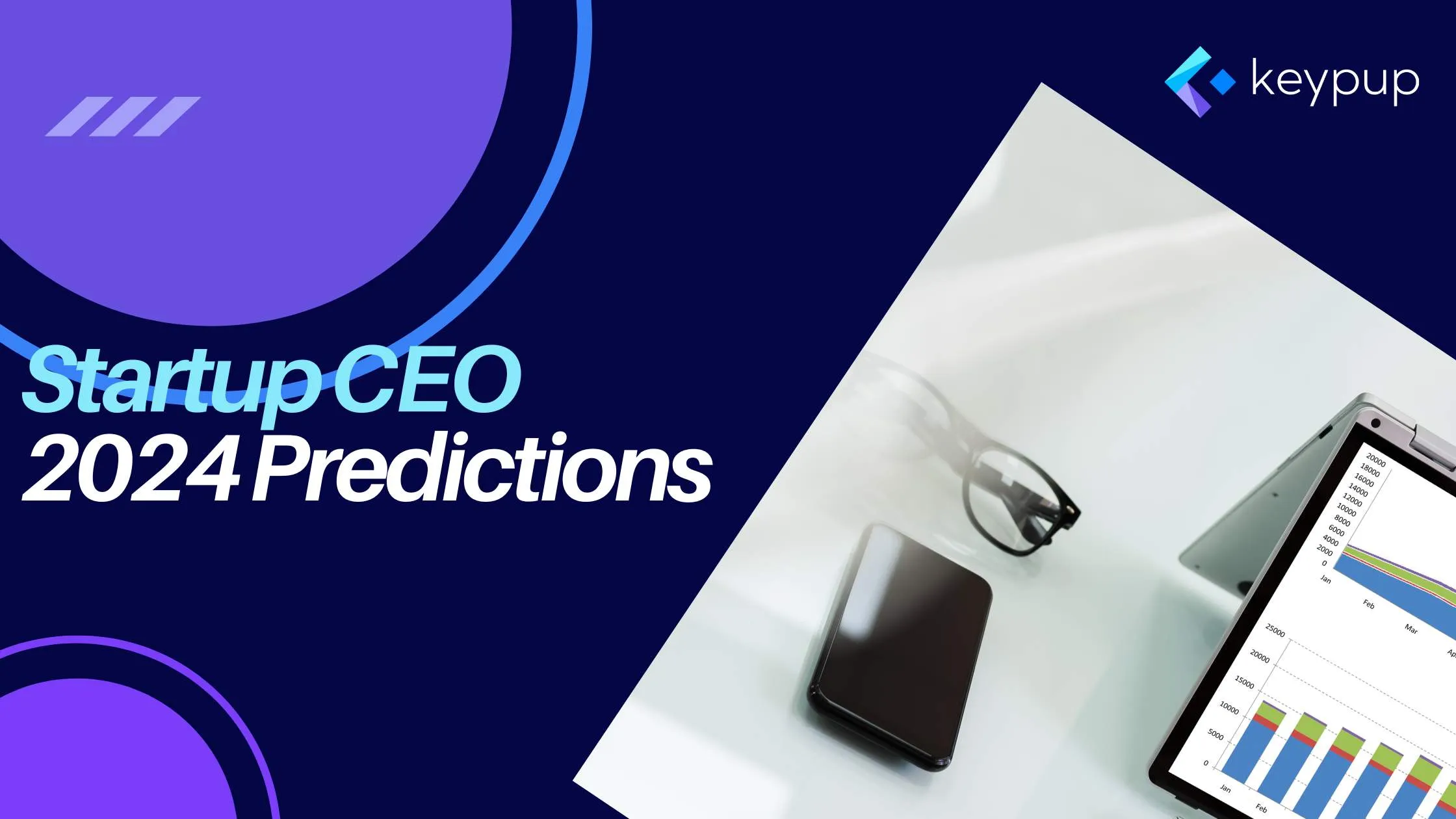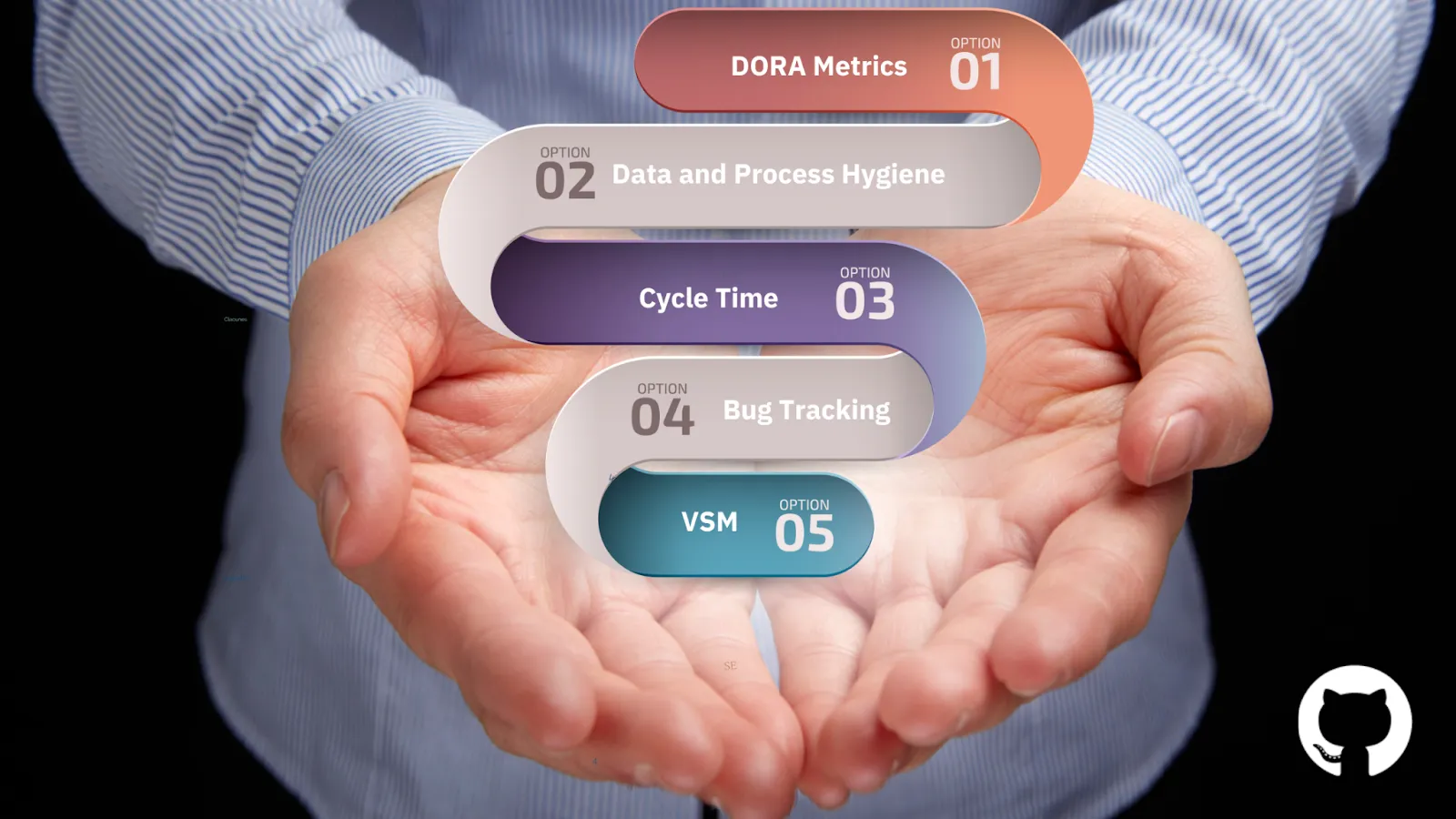2024 Vision: Startup Founder and CEO's Top 5 Business and Tech Predictions



As we step into 2024, digital transformation has become a burning priority in order to thrive in the modern business arena. This transformation is more than just a technological leap; it represents a fundamental overhaul in the way businesses operate, engage with customers, and position themselves in the global economy. Keypup CEO and co-founder, Stephane Ibos, shares his vision and five key predictions for 2024, emphasizing that digital transformation is not merely an option but a critical imperative for both survival and growth in this rapidly evolving digital era.
In this article, we delve into these insightful predictions, exploring the forces propelling this digital shift. We'll examine the evolving customer behaviors requiring more personalized and secure interactions, the emergence of advanced technologies like Artificial Intelligence (AI) and Machine Learning (ML) transforming business operations, and the significant changes in the competitive landscape that are redefining industry standards. We will also highlight the essential areas of focus for businesses in 2024, including cloud computing, AI and ML adoption, and the strategic importance of data analytics.
This comprehensive overview serves as a roadmap for businesses gearing up for a digitally driven future. It's a call to action for companies to adopt a holistic approach in their digital transformation journey – from standalone technological upgrades to a complete rethinking of business models, strategies, and customer relations. For those ready to embrace this change, the path ahead is bright with potential for innovation, growth, and sustained success beyond the digital frontier.
As we embark on 2024, digital transformation has evolved into a critical component for business success across all sectors. It is not about just adopting new technologies anymore, but rather about understanding and implementing a fundamental shift in how businesses operate, interact with customers, and compete in the global market. Digital transformation is no longer a choice but an imperative for survival and growth.

One of the most significant drivers of digital transformation is the evolving expectations and behaviors of customers. In an increasingly digital world, consumers expect more personalized, efficient, and secure experiences. Businesses are thus compelled to reimagine their customer engagement models, leveraging digital channels and tools to meet these expectations.
The rapid advancement in technologies like AI and ML is reshaping the business landscape. These technologies are not just improving existing processes; they are opening doors to new possibilities – from predictive analytics to enhanced customer interactions. Their role in strategic decision-making and operational efficiency is becoming increasingly pivotal.
The competitive environment across industries is undergoing a seismic shift. In this digital age, companies that adapt to digital transformation are not just gaining a competitive edge; they are setting the new standard for doing business. Those unable or unwilling to keep up risk obsolescence and ultimately demise.
Cloud computing has emerged as a backbone for digital transformation. Its benefits – scalability, flexibility, and cost-efficiency – are indispensable for businesses looking to innovate and grow. The cloud enables companies to deploy and scale applications rapidly, adapt to market changes, and reduce IT overhead costs, while lowering balance sheet liabilities – which is always a good thing in times of financial hardship.
AI and ML are revolutionizing the way businesses operate. From automating routine tasks to generating insights from data, these technologies are enhancing efficiency and decision-making. In customer-facing roles, AI is enabling more personalized and engaging experiences, setting a new standard in customer service.

Data analytics has become a cornerstone in understanding market trends, customer preferences, and operational efficiencies. Investing in analytics allows businesses to make informed, data-driven decisions. The insights gained from analytics are invaluable in crafting strategies that resonate with customers and drive operational and business growth.
As we look to 2024 and beyond, the message is clear: businesses must embrace and adapt to digital transformation to thrive. This journey involves more than just adopting new technologies; it requires a fundamental rethink of business models, strategies, and customer engagement. For companies willing to make this leap, the future is bright, filled with opportunities for innovation, growth, and sustained success in an increasingly digital world.
As 2024 unfolds, the business world is witnessing a revolution in decision-making processes, heavily influenced by data and analytics. This trend is particularly pronounced in software development analytics, where data is becoming a cornerstone for strategic planning and execution.

Today's businesses are tapping into a wealth of data from varied sources – internal systems, customer interactions, external markets, and especially from software development processes. This eclectic data collection is vital for gaining a comprehensive view of operational and business performance as well as market opportunities and threats.
Businesses are employing sophisticated analytics tools not only to decipher vast datasets but also to draw actionable insights. In the realm of software development, this analysis is critical for understanding user behavior, improving product features, and streamlining development processes. Software development teams are shifting from an obscure “black-box” paradigm to a metrics-driven and holistic reporting approach.

Data-driven strategies are revolutionizing how businesses approach operational efficiency. In software development, this translates to more agile methodologies, better resource management, and fully optimized development cycles.
Innovative products and services are increasingly born from data-driven insights. This is particularly true in software development, where data informs everything from feature prioritization to user interface design, ensuring products meet market demands and user expectations.
Data analytics is transforming marketing strategies, making them more responsive to market trends and customer needs. Integration of these insights with software development ensures that products are not only well-marketed but also well-aligned with customer expectations.
Data is key to personalizing customer experiences. In software development, this extends to creating intuitive and user-friendly interfaces, tailored to meet the needs and preferences of the end user.

With the increasing reliance on data, issues surrounding privacy and security are more prominent, especially in software development. Ensuring good security practices are firmly adopted during all phases of software development is key to the integrity of products and services. Businesses must navigate these challenges carefully, to guarantee good levels of security to their users and gain their trust.
Effective use of data in software development can be a game-changer, offering a significant competitive advantage. This involves not just collecting data, but also interpreting it in ways that drive innovation, quality, and efficiency.
As we move through 2024 and beyond, it's clear that data-driven decision-making is key to business success, particularly in the field of software development. Businesses that effectively harness the power of data will not only stay competitive but will also take the helm in innovation and customer satisfaction in the digital age.
As 2024 marches on, the gig economy is not just surviving; it's thriving. This sector, characterized by freelance work and short-term contracts, has become a significant part of the global workforce, challenging traditional employment paradigms and reshaping the labor market.

The gig economy is marked by its flexibility, autonomy, and varied opportunities. It appeals to those seeking work-life balance, autonomy in their work, and the chance to engage in diverse projects.
Key factors fueling this growth include technological advancements that facilitate remote and freelance work, as well as a workforce increasingly seeking flexible and independent work arrangements.
To stay relevant, businesses are adapting by offering flexible work arrangements. This not only aligns with the evolving workforce preferences but also opens up a broader talent pool.
Forward-thinking companies are extending benefits to gig workers. This includes access to healthcare, paid leave, and professional development, which are crucial in attracting and retaining top talent.
Investing in skills training and development is essential. Such programs not only enhance the quality of work but also help gig workers stay competitive in a rapidly evolving job market.
Remote work, a cornerstone of the gig economy, continues to grow. The flexibility and cost-effectiveness of remote work are appealing to both workers and employers, with many studies showing no adverse effects on productivity.

Contrary to some beliefs, remote work has not shown a significant negative impact on productivity. In fact, many studies indicate increased productivity and job satisfaction among remote workers.
The gig economy also presents legal and compliance challenges, particularly in areas like worker classification and benefits. Businesses must navigate these carefully to maintain compliance and ethical standards.
Technology plays a crucial role in managing a gig workforce. Tools for scheduling, communication, and project management are essential for seamless operations in this new work paradigm.
As we continue through 2024, it's clear that the gig economy is not just a passing trend, but a key component of the modern workforce. Businesses that adapt to this model will find themselves at the forefront of a flexible, dynamic, and efficient work environment, ready to meet the challenges of a changing world.
In 2024, as AI becomes increasingly integrated into our daily lives and business operations, the focus on using AI responsibly and ethically has never been more important. The drive toward responsible AI is about ensuring that these powerful technologies are developed and deployed in a way that benefits society while minimizing harm.

The creation of ethical guidelines and frameworks is central to responsible AI. These guidelines, developed collaboratively by governments, industries, and academic bodies, emphasize fairness, accountability, and transparency. They serve as a foundation for ethical AI development, ensuring that AI systems do not perpetuate bias or unethical practices.
We are witnessing a significant rise in collaborative efforts to establish ethical AI practices. These partnerships are crucial in setting global standards and sharing best practices for responsible AI development and use.
One of the most critical challenges in AI is addressing and eliminating bias in algorithms. Efforts are underway to ensure AI systems are fair and unbiased, involving rigorous testing and validation methods to identify and eliminate biases.
Transparency in AI systems is essential for trust and accountability. This involves making AI decision-making processes more understandable to users and stakeholders, ensuring that AI acts in predictable and explainable ways.

AI's impact on the workforce, particularly concerning job displacement, is a significant concern. Strategies like reskilling programs and job transition plans are being implemented to mitigate this impact, ensuring a smooth transition for the workforce into the AI-augmented future.
There is a growing awareness of the risks associated with AI in critical decision-making. Safeguards are being developed to ensure that AI supports, rather than undermines, human decision-making, especially in sensitive areas like healthcare and criminal justice.
The governance of AI through national and international policies is becoming more pronounced. These policies aim to regulate AI development and use, ensuring that AI benefits society as a whole while mitigating potential harms.

Industries are increasingly adopting self-regulatory practices and standards for AI. These initiatives are crucial in maintaining ethical practices in AI development and use, promoting a culture of responsibility within the AI community.
As we continue through 2024, the path forward for AI is clear: a commitment to responsible, ethical, and transparent AI is essential for the sustainable and beneficial development of these technologies. Embracing responsible AI practices is not just a technical or regulatory challenge, but a societal imperative, ensuring that AI serves as a force for good in our increasingly digital world.
As we progress through 2024, alternative finance continues to carve out a significant niche in the global financial landscape. This realm, encompassing a variety of nontraditional funding sources, is becoming a go-to option for businesses and entrepreneurs, offering flexibility and accessibility that traditional banking often lacks.

Alternative finance encompasses diverse models like crowdfunding, peer-to-peer (P2P) lending, and invoice financing. Each model offers unique advantages, from the communal backing of crowdfunding to the direct loans of P2P lending, and the cash flow solutions provided by invoice financing.
The appeal of these methods lies in their flexibility and lower barriers to entry. Unlike traditional banking, which often involves rigorous credit checks and collateral, alternative finance provides a more accessible platform for businesses to secure funding.
Crowdfunding platforms have seen exponential growth, democratizing the investment process. These platforms allow individuals and businesses to present their ideas to a wide audience, garnering financial support from backers around the world.
The impact of crowdfunding is evident in numerous success stories where businesses have launched innovative products and projects that might have struggled to find funding through traditional means.
Peer-to-peer lending connects borrowers directly with lenders through online platforms, bypassing traditional financial institutions. This model often results in more favorable terms for both borrowers and lenders, facilitated by the efficiency of digital platforms.

P2P lending has become particularly vital for small and medium-sized businesses, offering them an alternative route to capital without the hurdles of conventional bank loans.
Invoice financing allows businesses to manage their cash flow by using their unpaid invoices as collateral for funding. This method is particularly useful for businesses with longer invoice cycles, providing them with immediate working capital.
The key advantage of invoice financing lies in its flexibility and speed, offering immediate liquidity and helping businesses to maintain steady operations without the wait for invoice clearance.
While alternative finance offers numerous advantages, it also comes with challenges, particularly in navigating the diverse regulatory frameworks that govern these financial models.
Understanding and balancing the risks and rewards is crucial for businesses engaging in alternative finance. While these methods offer easier access to funds, they also come with their own set of risks, which must be carefully assessed.
As we look ahead, the trajectory of alternative finance points toward continued growth and innovation. This sector is reshaping how businesses think about funding, offering more inclusive, flexible, and responsive financial solutions. The future of finance in 2024 and beyond seems poised to be increasingly dominated by these alternative models, reflecting the evolving needs and dynamics of the modern business world.

As we navigate through the varied and insightful predictions for 2024 shared by Keypup CEO, Stephane Ibos, it becomes evident that this year marks a significant turning point in the journey of digital transformation. The insights presented in this article underscore the vital need for businesses to not only embrace technological advancements but to fundamentally rethink and reinvent their operational, strategic, and customer engagement models to stay relevant and competitive in an increasingly digital world.
The rise of AI and ML, the shift in customer expectations toward more personalized experiences, and the evolution of the competitive landscape are not just trends but signals of a deeper transformation occurring across industries. The adoption of cloud computing, the strategic use of data analytics, and the integration of cutting-edge technologies into every aspect of business operations are no longer futuristic concepts but immediate necessities.
The emergence of alternative finance, including crowdfunding, peer-to-peer lending, and invoice financing, further enriches this transformative landscape. Offering unparalleled flexibility and accessibility, these non-traditional funding sources are crafting a new paradigm in business financing, challenging the status quo of traditional banking. The growth of these models not only provides businesses with varied funding options but also democratizes the investment process, allowing for a broader engagement in financial growth opportunities.
As we look toward the future, the message is unmistakably clear: the businesses that will thrive are those that view digital transformation not as a one-time project but as an ongoing journey of innovation, adaptation, and growth. This transformation is more than just a technological shift; it represents a cultural and strategic overhaul that touches every part of an organization.
In embracing these changes, businesses will unlock new opportunities for growth, customer engagement, and market leadership. They will be able to navigate the challenges of a rapidly changing world with agility and foresight, leveraging technology not just as a tool for efficiency but as a catalyst for innovation and transformation.
In conclusion, as we progress through 2024 and beyond, it is imperative for businesses to adopt a mindset of continuous learning, adaptation, and innovation. By doing so, they will not only survive the waves of digital change but also set new standards of excellence, redefine industry norms, and emerge as leaders in a digitally transformed world. The future belongs to those who are prepared to rethink, reimagine, and reinvent – and the time to start is now.
